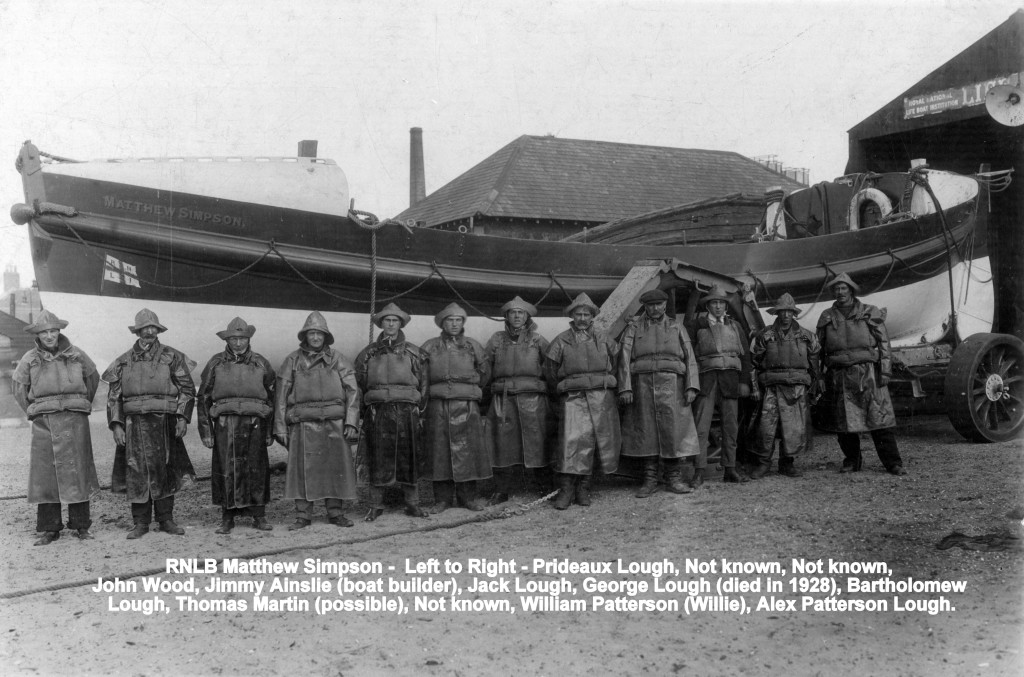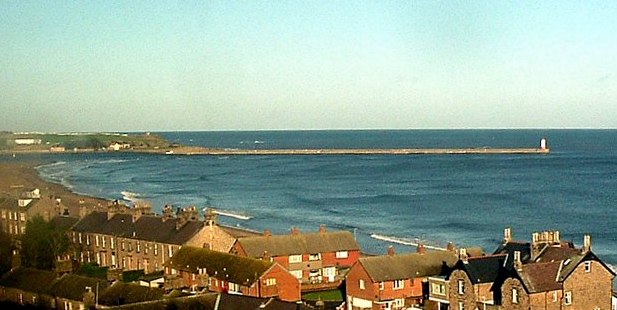BERWICK ADVERTISER, 3 MARCH 1916
LIFEBOAT RESCUE AT BERWICK
Swedish Schooner Wrecked on Spittal Point
The boom of the Berwick Coastguard mortar on Sunday afternoon announced that some vessel was in distress on the coast, and that the services of the lifeboat were in requisition. The boom came as a surprise to most of people, the weather being decidedly calm, though there was a somewhat heavy ground swell running at the river’s trast to the preceding one when a strong easterly gale prevailed. The danger signal was the sequel to the ugly weather which had prevailed in the earlier part of the week. There was naturally a big rush of the inhabitants to the ramparts and the pier. Very soon these points of vantage, as well as Spittal sands, were thickly dotted by many hundreds of spectators. They were privileged to witness a very smart performance of an extemporised lifeboat crew which accomplished the rescue of five hands from a Swedish schooner, which had stranded on the seaward side of Spittal Point. The task of removing the men from the vessel was completed in half an hour, itself indicative of the care with which the Berwick lifeboat was handled in somewhat difficult and broken water, though the absence of any wind was a factor which considerably helped the completion of the mission of merey. A gratifying feature was that for the first time in its history the lifeboat brew was composed of a joint crew from Berwick and Spittal. Many of the regular crew are presently away on military and naval service, and the local Lifeboat Committee are particularly pleased at the able assistance rendered by the Spittal men, no less than eight of these forming part of the crew, the others coming from the Greenses. The coxswain was Mr James Jameison, who rendered many acts of conspicuous service.

The vessel in distress turned out to be the Swedish schooner Ruth, under the command of skipper Gustav A. Nelsen, and a crew of other four. She belongs to Holmstead, and is 87 tons register. She left on her voyage on Wednesday 16th February, with a cargo of pit props for the Tyne, encountering very bad weather on the voyage. So violent was the storm that the little craft anchored for two days in Elsinore Roads. On venturing out she was severely buffeted in the North Sea, and hove to on Saturday night to await day break so as to make land. At 10 a.m. on Sunday morning she found herself abreast of Berwick ten miles out. She was then on a lea shore, and in bad weather. The crew decided to make for Berwick, as the steering gear had been damaged. In attempting to take the river the vessel was driven into the back of Spittal point where she stranded. The heavy ground swell continued to break over the vessel and it was in such circumstances that the lifeboat crew affected the rescue. The skilful manner in which the lifeboat was taken through the breakers to the lea of the vessel, and the crew removed one after another was done with judgement and skill. The members of the crew took most of their personal effects with them in kit bags. The short homeward journey was also admirably taken, the lifeboat’s head being held well up to the breakers. Once these were passed and the river entered the remainder of the journey was easily undertaken. As the lifeboat glided up the estuary the crew received a well-merited cheer from the large crowds lining both sides of the river. On landing the crew were taken in charge of by the Swedish Consul (Mr A. Logan), and accommodated in the Hen and Chickens Hotel. On Monday the crew had to register at the Police Station under the Aliens’ Order. The vessel was some five years old, and was not originally intended for this trade, but owing to the absence of transport due to the war her services were requished. She commenced to break up in the course of the evening with the incoming tide and quantities of the cargo floating ashore were salved by Spittal fishermen. Dr C. l. Fraser, V.D., hon. Secretary of the Berwick Lifeboat Committee; and Mr Toohey, Collector of Customs, were in attendance when the crew landed at the Lifeboat House.
LOCAL NEWS
Record Salmon Catch by a Berwick Gentleman – The many friends of Mr Thomas Davison, second officer, Customs and Excise, Berwick, will be pleased to learn of his having caught a record large salmon. Mr Davison is presently on holiday, and, fishing on Friday last at Major Scott’s water at Grandtully on Tay, near Aberfeldy, he hooked and landed a splendid clean run salmon after two hours play, weighing 47 ½ lbs. Its length was 50 inches and girth 28 inches. It is believed to be the largest salmon which has been caught by rod and line in the Tay for a number of years, constituting a record for this part of the river, the nearest approach being a fish of 44 lbs caught three years ago. In a letter to a Berwick friend Mr Davison stated that his left arm was still sore with the severe strain.
Sunday last was the anniversary of laying of the foundation stone of Berwick Pier, on Feb. 27th 1810. It was a red-letter day in the old Border town. The different lodges of Freemasons from the neighbouring towns, together with that of Berwick, assembled in the Town hall, along with the magistrates, Commissioners, and townspeople, and walked thence in procession to the church, where a service was held. Afterwards they set forth, attended by a band and a detachment of the Forfarshire Militia, then quartered in the town, and after the stone was laid a royal salute was fired from the cannon on the ramparts and the ships in the harbour.

Extraordinary Incident in a Tweedmouth Church – An extraordinary incident occurred on Sunday afternoon in the Scotch Church, Tweedmouth, at the close of some pathetic remarks the minister (the Rev. Mr Bryson) had made on Belgium and its refugees. A prominent member rose in his seat and shouted – “Are we downhearted? No!” He gave great emphasis to the last word, and wound up by a hearty clap of his hands. It is needless to say the unusual incident came as a great surprise to the minister as well as the congregation, many of whom could not suppress a smile. The minister was evidently considerably perturbed at the outburst, but took no notice of it.
PIGEON SHOOT AT WOOLER
The pigeon shoot, open to all England, inaugurated by Mr A. D. Morton of the Red Lion Hotel Wooler, last year was such a success that he decided to continue it as an annual event. Favoured with fine weather, there was a large gathering and considerable interest was taken in the shooting, which was good, and speculation was brisk. As an extra inducement Mr Morton, in addition to guaranteeing £20 for a Handicap, gave a handsome silver cup to be won outright. Shooters responded in great force, and the proceedings were an unqualified success. Mr J Hall was handicapper; and H. Gibson acted as trapper. The birds were supplied by Mr G. Gallon, Wooler; and proved to be strong on the wing. A tent was erected on the ground where soup and light refreshments were provided by Mr Morton. After the shooting a considerable number sat down in the Red Lion Hotel, when a sociable evening was spent. Shooting commenced with a sweep stake but the handicap was the great attraction, and it resulted in a division of eight, but three of these had two lots. The cup was won outright by Mr. J. Sisterton, and his victory was a very popular one. The shoot took place in a field on Wooler Bridgend Farm.
During the First and Second World War, carrier pigeons were used to transport messages back to their home coop behind the lines. When they landed, wires in the coop would sound a bell or buzzer and a soldier of the Signal Corps would know a message had arrived. He would go to the coop, remove the message from the canister, and send it to its destination by telegraph, field phone, or personal messenger.


